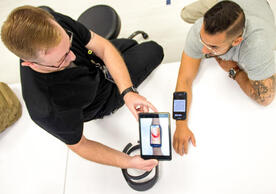
Working with partners across campus, acute care Yale School of Nursing (YSN) student Travis McCann ’20 MSN is pursuing two exciting projects to help providers become better clinicians. His team has developed a visual and auditory hallucinations app that allows participants to better appreciate the challenges these patients face. They are also working on a clinical simulation app that combines an augmented reality (AR) headset with paper-printed QR codes and CPR manikins to facilitate portable and low-cost clinical training.
The hallucinations app encourages students to explore beyond textbook theory. For example, as displayed on an AR headset, the app might show a lizard riding a squeaky bicycle around the room during a job interview scenario. This gives the provider a clearer understanding of how distracting and disorienting it is for patients to apply critical thinking skills under those conditions.
McCann’s teammate Joe Albertario ’20 MSN, a student in the psychiatric-mental health specialty, agrees. “You achieve more successful outcomes for the patient when the provider has greater empathy,” Albertario said. “Time spent with the patient increases, the provider can imagine what the patient is going through, and the list of differential diagnoses increases. That means there’s a better chance that I can identify the case correctly. All this leads to Yale producing better nurses, with better understanding, and better health.”
In the clinical simulation app, a QR code is placed on a simulation manikin or an instructor’s body and the AR system displays the code as a wound or an injury from a library of options. Students then respond to assess the problem and provide treatment. Instructors can reset the exercise for a new class or a different specialty in just a few minutes.
Forging Partnerships Across Yale and Beyond
To gain the expertise he needed for the apps, McCann sought advice from the Center for Creative Arts at Media (CCAM) at Yale, where he connected with then–undergraduate student Bobby Berry ’19, now the main developer of the apps.
“I truly believe that it was thanks to Travis coming to CCAM that the project was able to get off the ground,” Berry said. “Furthermore, blended reality is privileged with corporate sponsorship, and interest, which helps us to acquire tech and provides us with opportunities to talk with industry professionals about our ideas.”
McCann enthusiastically describes the Center’s contributions to his project’s success. “CCAM asks: ‘What’s your idea? How can we help you?’” he said, emphasizing that CCAM guides students toward their goals without taking over the projects. Rather than just recreating an existing exercise with blended reality, McCann wanted to explore new possibilities. “What things could we not do before that this technology now allows us to do?” McCann said.
The team’s dual projects make considerable improvements over existing technology. One strength is the app’s ability to demonstrate visual hallucinations. And the QR codes for the clinical simulation app bypass the need for hours of makeup application and reapplication as an exercise is repeated for new students or classes. Wounds can be mapped to an area but then changed easily, creating entirely new scenarios better suited to each nursing specialty.
Exploring new territory and taking advantage of the team’s unique skillsets clearly resonated with Berry. “I think the nursing sim project is particularly exciting because it’s really trying to build a new form of hands-on education,” he said. “One of the greatest new potentials with augmented reality/virtual reality (AR/VR) is its function as a training tool. Research has shown it to be effective in developing certain motor skills as well as observational skills, so really our project is a perfect combination,” Berry said.
Berry is now the CCAM and Tsai CITY (Center for Innovative Thinking at Yale) Innovation Fellow, and his teamwork with McCann continues.
Affordable and Portable Kits
“Not everyone has access to Yale SIM,” McCann said, and that goes for the pricey equipment inside YSN’s state-ofthe-art simulation spaces. For example, a life-size high-fidelity mannekin with the capability to breathe, bleed, and talk costs upwards of $100,000 and a high-tech AR headset retails for about $3,000. But the blended technology McCann, Albertario, and Berry are developing is portable and much more affordable.
A small kit consisting of a CPR chest dummy for a few hundred dollars, a simple VR viewer that substitutes for the hightech headset at less than $10, and a used smartphone are all you really need. The equipment fits into a backpack and can be stowed in an airplane’s overhead bin.
“Travis demonstrated his blended reality simulation to our Dean’s Leadership Council earlier this year, and the room was astounded by all the possibilities,” said Dean Ann Kurth ’90 MSN, PhD, CNM, MPH, FAAN. “This application of blended reality reaches across all specialties and it can make even the most remote communities accessible for improvements in training and clinical care. The ability to provide portable, low-cost equipment will empower providers to master a variety of patient scenarios, leading to better health care delivery. Travis, Joe, and Bobby have done a terrific job connecting with resources across all of Yale, and this is the type of solution-driven innovation that can result from those partnerships.”
What’s Next
The team is exploring possibilities with experts at Yale School of Medicine and Yale School of Management and investigating how best to measure empathy in providers before and after using the app.
“Once data are collected and our evidence shows that virtual training improves outcomes, creating new virtual reality simulations for all nursing competencies could revolutionize healthcare training and vastly improve quality of patient care,” Albertario said.
